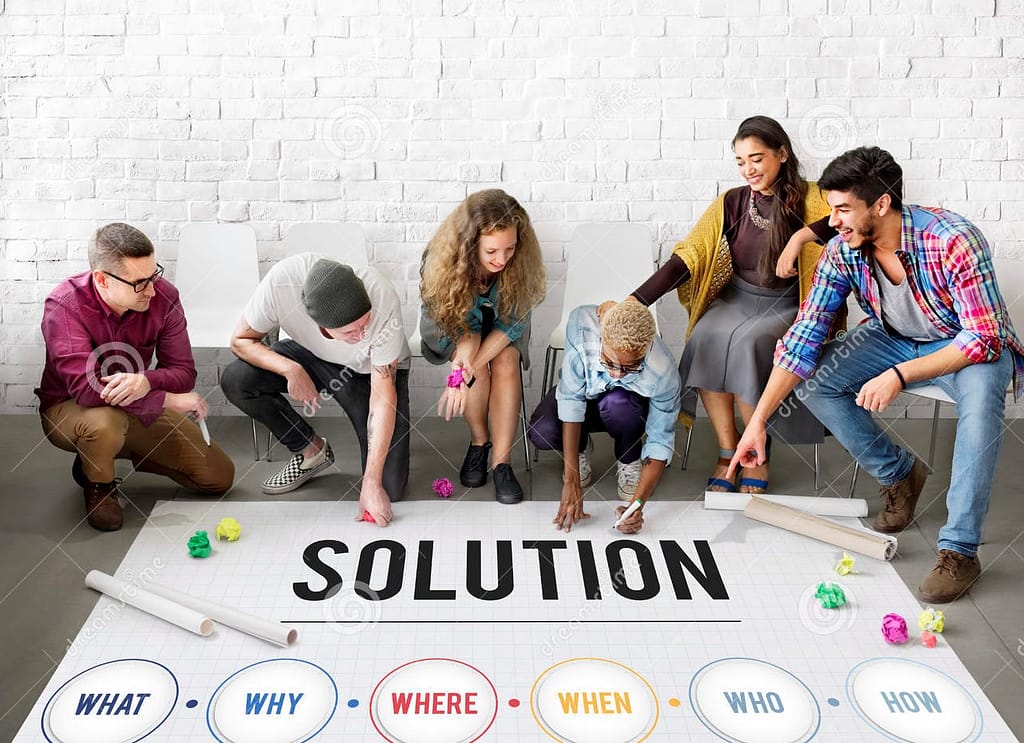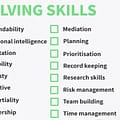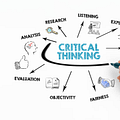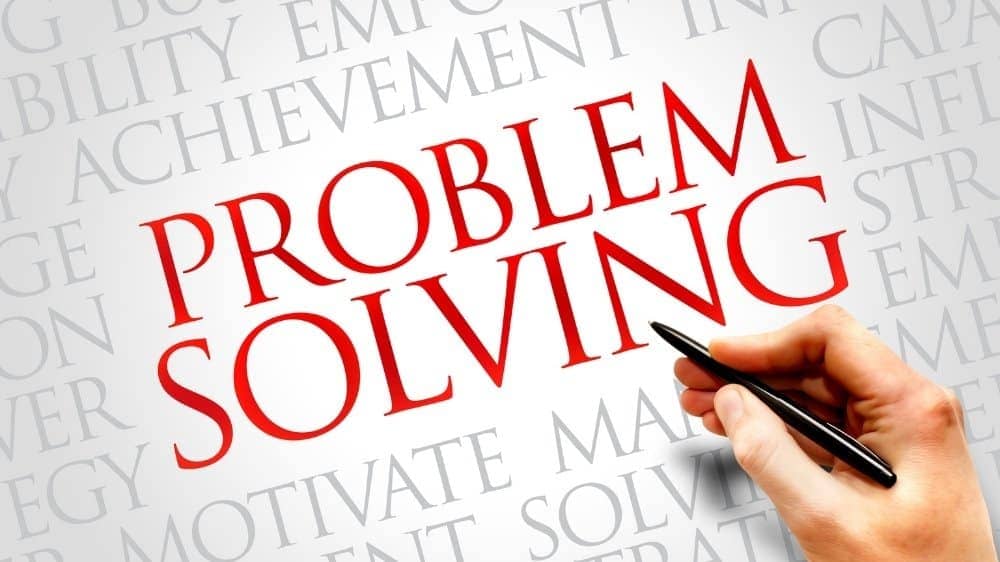‘’Effective problem solving is one of the key attributes that separate great leaders from average ones.’’
All successful leaders have problems and the key thing that separates a successful from an ordinary one is the ability to solve problems effectively.
Employers love to hire managers who are good at problem-solving because they help the organization progress faster, they save time, effort, and stress in the organization.
You may have other leadership or management competencies, but if you lack problem-solving skills, then you will have a hard time trying to solve more complex problems as you go up the success ladder.
Because as you go higher, you will be facing complex problems.
You will have to take responsibility for team failure and progress.
So if you want to go higher, developing problem-solving skills is very essential to your career growth and the growth of your team and organization.
To help you become more successful at problem-solving as a New Manager, I have put together a step-by-step systematic way to solve any problem.
So here are the only 8 simple steps needed to solve any problem effectively.
Do You Want To Solve Problems Like a PRO ?
Get the FREE Problem Solving Work Book HERE

1 . BE OPTIMISTIC
2 IDENTIFY AND DEFINE THE PROBLEM
3 ANALYSE THE PROBLEM
4 LOOK FOR THE ROOT CAUSE
5 BRAINSTORM POSSIBLE SOLUTIONS AND PICK THE BEST ONE
6 SET A DEADLINE TO SOLVE THE PROBLEM
7 IMPLEMENT THE SOLUTION
8 MONITOR AND EVALUATE THE RESULTS
1BE OPTIMISTIC
Problems are part of life, you cannot control what can happen, but you can keep a positive outlook on how you will deal with them.
Remember it is just a situation that will go away.
If you are stressed, you will think of all the worst things that might happen and go down the spiral of negative thinking and might end up panicking and intensifying the situation.
On the other hand, if you take a step back, have a look at it as any other challenge, and approach it with a positive frame of mind, ie feel optimistic about getting a solution for it, you will feel more confident.
If you are optimistic and confident you will be able to think out of the box and devise creative solutions and in time you will be able to overcome it more sportingly.
So the first step in any problem solving is to have a positive approach towards the problem and treat it like any other challenge or temporary situation.
One such self-empowering talk can be -’’ I am calm in all situations.’’ ‘’I am confident. ‘’I can solve any problem effectively.”
2 . IDENTIFY AND DEFINE THE PROBLEM
To identify the problem know what you are trying to solve. Get clear on what the problem is. What is wrong or what needs to be improved.
Ask one question to yourself,’’ If I would have things going my way, what would the ideal situation be like ?”
After identifying the problem, define the problem as clearly as possible.
Defining the problem gives you the definition of the opportunity and a goal to solve it.
Write down what situation is causing you stress and anxiety. Knowing exactly what the challenge is, makes it easy to resolve it.
State the problem as clearly as possible. For example:
Sammy is failing project deadlines.
Be specific about the behavior, situation, timing, and circumstances that make it a problem.
For example:
“ Sammy has been failing deadlines 5 to 6 times in the last 2 months in this particular project .”
Defining the problem makes it easy to find the solution.
If you don’t define it, it makes it impossible to find the solutions.
Suppose you have a direct report who is an expert in his work and behaves well but is failing deadlines five or six times in a row.
From a manager’s perspective, it would be less tolerable.
You may think of firing him or taking him to a task or might be thinking of getting a replacement.
But if you set aside some time to talk to him and know why he is failing the deadlines each time, you may uncover some issues like, he might be having some health problem, or family problem or might not be feeling motivated enough to do the work or has poor time management skills or is unable to prioritize his work.
If you are solving problems with your team, take everyone’s opinions in the group or team, because everyone will be having something different to say and then arrive at a common consensus.
3 . ANALYSE THE PROBLEM
Analyze in which stage the problem is. This will help in knowing the urgency to solve it.
Is it the beginning stage, middle stage, or advanced stage -crisis?
If it is in the beginning stage, you have some time to think about it and find a solution to solve it.
The middle stage means, some minor damage has already been done, if you neglect it, it can become worse and get out of hand. So you need to fix it as fast as possible.
The advanced or crisis stage means the problem is serious and the consequences are greater, deeper, and more expensive.
It means that real damage has been done to the organization’s name, and finances and poses a potential threat in the future, causing the complete shut down of business.
So analyzing the stage of the problem helps you to decide whether it can be attended to later on, very soon, or immediately.
It helps you prioritize it and manage your time wisely.
4 . LOOK FOR THE ROOT CAUSE OF THE PROBLEM
Look at the problem from different perspectives.
Your perspective may not always be right.
Taking an overview of the whole situation instead of having a tunnel vision is very critical because multiple factors are affecting the situation.
So taking a step back and seeing things, on the whole, is very important. Have a holistic view.
Some questions you can ask in this stage are :
What is the cause of this problem?
Who is responsible for it?
When did it first occur?
Why did it happen?
How did the deviation happen?
Where and how does it harm us the most?
How can we resolve this?
Is it worth solving?
How can we ensure that it never happens in the future?
If you have a team, taking a viewpoint from others helps to see the problem in a much better light and bring more powerful solutions to the problem.
Devising long-term solutions to some problems is very important for a team leader and benefits the organization and its members in the long run.
5.BRAINSTORM POSSIBLE SOLUTIONS AND LOOK FOR THE BEST ONE
Brainstorming is essential to solving problems because there can be multiple solutions to one problem and the first solutions that you may come up with may not be the best one.
If your problem is complex, you will need many solutions. If you concentrate more, you will find many solutions.
Think of what your ideal solution would look like. Keep the end goal in mind.
Make a list of pain points and brainstorm at least 10 solutions.
Be creative and do not worry about the quality of solutions.
Keep in mind not all solutions you have listed will be a good fit.
After brainstorming all solutions, the next logical step would be to explore all the solutions and think of one solution that will produce the best outcome.
Analyze the solutions and choose the best solution for you.
While analyzing the solutions, write down the solutions in order of preference.
A good way will be to rank your solutions based on time, cost, resources, practicality effectiveness, long-term value, and minimal side effects after implementation.
Eliminate the less desirable ones by considering their advantages and disadvantages. See which is most effective for your problem or situation.
Narrow down your choices to one solution which will be most effective.
Consider the opinion of all who need to have a say in the decision making, for example, team members or your boss, etc.’
Ask yourself questions –
If there is one solution to solve all the pain points what would that be?
Which one is the best under the current circumstances?
What will successfully solve the problem?
Will it meet the goal?
How will it impact the situation positively?
Is it affordable?
How many side effects can it have?
What is the standard norm against which you will measure it. ?How much deviation from the norm would you allow?
Now explore the risks associated with the solutions. Risk management will help you to make a good decision.
Take the best solution and ask yourself -what will be the repercussions of the solutions.
Explore all the worst-case scenarios.
*How important is this decision?
-
How will this impact me a year from now?
-
What effect will this decision have on my team and the company?
-
What can I do if I make the wrong decision here?
-
What’s the worst thing that could happen?
-
What will happen if the solution fails?
This will help you to prepare mentally if the solution does not solve your problem. Even if you don’t succeed in the first attempt, you will have something to learn from it.
Don’t take it as a failure. On the contrary, accept the fact that it didn’t work and try something new.
You already have a list of other ideas while you brainstormed them. You can use it to find the right one.
6 SET A DEADLINE FOR THE SOLUTION
Now that you have found the solution, set a deadline for the solution -ie when you will end it.
7 IMPLEMENT THE SOLUTION AND SOLVE THE PROBLEM
Now that you have set a deadline. It is time to implement it.
You need to create an implementation plan.
Here are a few guidelines for implementing effectively.
In the implementation plan, it is important to include a list of people who know and understand their role in making the solution work.
Have a set timeline for executing the plan.
Keep a system to track whether the solution has been effective or not. Has it corrected the problem or not?
Keep a fallback plan to manage risk. If something goes wrong with the solution, or it did not work out the way you thought it would what would you do next?
The key thing to keep in mind is to have short cycles of implementation, test the solution and get feedback on it.
Avoid trying to be perfect in the first shot. A bare minimum viable plan is the best and goes on developing it as it works.
When you implement something new it takes a lot of time, it requires patience and persistence.
Since many people are involved in the change process, it is essential to be patient while carrying out the plan.
Not everyone on the team will be open to accepting the change. New habits need to be formed. To form any new habit, it needs a minimum of 2 months to develop a new habit.
It is wise to implement the plan little by little so that team members do not get overwhelmed and you too do not become heavy with resolving issues that surface during the change.
As a team leader, you will need to encourage them and ensure everyone stays motivated and engaged in making the change possible, resolve issues that come up, take accountability, help them with their mindsets and resolve conflicts that can happen during the process.
You have to be persistent in your efforts by continually taking the action, and monitoring the changes. Ensure that all team members are implementing the changes every week and developing new habits.
Look out for inconsistencies in the team members, because it will delay the process and water down all the efforts.
Set a time frame to implement the new solution or strategy. How long it will take to complete the process and when do you expect to see the results.
Set a deadline for the solution -ie when you will end it.
Set clear goals, address all the problems or possible obstacles, and set a course of action. Delegate responsibility to them and communicate expectations to them.
Now go one step deeper in the planning process:
Set clear goals.
Address all the problems or possible obstacles.
What will be the options?
What will be the necessary actions to complete the goal?
Who will carry out the necessary actions -people, departments, and areas you need help with.
Delegate responsibility to them and communicate expectations to them.
(Ensure that everyone knows what they have to do when they need to do it, and how you will define the successful or unsuccessful completion of the job.)
How and when the solution will be implemented -from which day date it will start and what are the actions to be carried out in the beginning.
How will you know you are making progress? How will you measure success?
What standards will you compare it with? How will you compare the success of this solution against the success of another?
Determine what key performance indicators will allow you to measure the success of your outcomes and set a series of short-term deadlines to report.
8 MONITOR AND EVALUATE THE RESULTS
Monitoring and Evaluating the results is the final step of the problems solving process.
It’s important to review what worked, what didn’t, and what impact the solution had.
It also helps you improve long-term problem-solving skills and keeps you from re-inventing the wheel.
The final part of the problem-solving process is to analyze the results.
This can be done after a couple of weeks, months, or years, depending on what you are trying to change or achieve. It’s important to remember why this problem started in the first place and how it was affecting the company.
Ask yourself any of the following questions to better evaluate the results:
In the step before this one, you have set deadlines, defined the Key performance indicators, and scheduled reports.
Using that as a baseline you will be able to understand whether you have successfully solved the problem or not.
Ask questions like –
Is everyone aware of the original problem, the solution created, and why it was created?
Were you able to meet the goals you set out for in the beginning?
Did you do it in the time frame you set out in the beginning?
How effective was the solution? Did it help in solving the problem?
Are there any new problems arising since this process has begun?
Are any of our processes being interrupted by the previous problem?
Is there a possibility the issue can return?
What worked well and what did not?
Does the existing plan needs to be revised, or whether a new plan needed to better address the problem.
Do you need to change any policy, procedure, or personnel to avoid this from happening again?
.
What did you learn from the process that you can apply to other problems of similar kinds?
Look for insights, case studies, and bullets.
If you are not pleased with the outcome, return to step 2 to select a new solution or revise the existing solution, and repeat the remaining steps.
Answering these questions will allow you to understand if you need to take further action and help you improve your problem-solving methods for the future.
These 8 simple steps will help you become a more effective, efficient problem solver in your organization.
As you practice this process and develop the skills, these steps will become more natural to you until the point that you are using them without noticing!
CONCLUSION
Problem-solving is something we do every day.
Some problems are small or easily solved – others are more complicated and can seem overwhelming.
It’s unnecessary to feel overwhelmed and confused when a problem arises.
Stress and unhappiness come from how you respond to those situations. When you enhance your problem-solving skills, you will experience determination when the next difficult situation arises.
Learning to solve problems effectively will help you to minimize the level of stress in your life and improve your overall sense of well-being.
While you may not know how to resolve most issues right away, you will know the problem-solving steps to take to uncover the best response: Define the problem, determine the cause, discover the best solution, take action, and analyze the outcome.
Follow this process over and over again and you will creatively solve your problems. After all, effective problem solving is a skill that you can develop with practice.
Problems will always occur no matter what situation you are in, so it’s important to know how to conquer them before they get out of hand.
Sometimes it is necessary to start the process completely over.
To make the problem-solving process easier, it’s best to simplify the solution as much as possible.
Try to focus on the solution rather than the problem.
Finally, be in the correct mentality to want to change.
This includes having the right mindset language, both are positive and open-minded.
With enough practice, any problem can be solved.
However, not every problem will be solved easily and you may encounter additional obstacles as you attempt to solve the initial problem.
You can overcome any drawback by tapping into your creative mind and taking action consistently and persistently until you reach your goal.
As you work hard, you won’t only uncover more solutions but you can develop your capacity to achieve more in the future
To deepen your Problem-solving skill here are a few things you can try –
-
Use Inversion
-
Try creative thinking by imagining yourself in a hypothetical and thinking about what got you there. Then think of ways how you would come out of it.
-
Ask Yourself Tough Questions.
-
Take up Online Courses or read books.
-
Solve Problems for your team members.
-
Improve your knowledge of your industry trends.
-
Play games like chess to improve strategic thinking or solve puzzles to find missing parts.
-
Practice stress relief or meditate to be calm.
I hope the post has helped you .
What have you learnt form it ? What will you put into practice ?
Please share your thoughts below .
Babita Sharma
Leadership Coach
P.S -Please share the post and help someone today .







